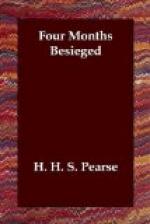Yesterday, watching a cavalry patrol that tried in vain to feel for a way through the scrubby nek into more open ground beyond, General Brocklehurst and his staff were nearly hit by a shell from some newly-mounted battery the exact position of which could not be located, for its smokeless powder made no flash that anybody could see in broad daylight, nor generated even the faintest wreath of vapour. Its projectile travelled faster than sound, so that the range could not have been great, but there was nothing by which our own batteries might have been directed to effective reply. We all abused “Long Tom” at first because of his unprovoked attack on a defenceless town, but by contrast with what is known among Devon men as the “Bulwaan Sneak,” and among bluejackets as “Silent Susan,” the big Creusot gun with its loud report, the low velocity of its projectiles, and the puff of white smoke giving timely warning when a shot is on its way, is regarded as quite a gentlemanly monster.
Following the example thus set by regiments on the main defensive positions, others temporarily in reserve have begun to build or dig for themselves splinter-or bomb-proof retreats, in which they may take shelter when the shelling becomes too hot. The Imperial Light Horse were first to hit upon the idea of burrowing into the river-banks. They began by forming mere niches, in which there was only just room enough for three or four men to stand huddled together when they heard a shell coming. Finding, however, that the soil could be easily dug out, they set gangs of natives to work lengthening the tunnels and connecting them by “cross drives,” in the planning of which several Johannesburg mine managers found congenial occupation. This went on until the river-bank for a hundred yards in length was honeycombed by dark caves, in which a whole regiment might have been hidden with all its ammunition, secure from shell fire, the walls and roofs being so formed that they needed no additional support. There was no danger of the stiff alluvial soil falling in even if a shell had buried itself and burst above the entrance to any of these cool grottoes.
[Illustration: A SHELL-PROOF RESORT
A culvert under a road used as a living-place by day for civilians, who returned to their houses when the shelling ceased after sunset]
I spent half an hour in one of them, and found the air there delightful by contrast with scorching sunshine outside. What it will be, however, after many people have been crowded together for some time is less pleasant to contemplate, but even for that the resourceful Imperial Light Horse are prepared, and they already begin to talk of air-shafts so cunningly contrived that light and air may enter, but shells be rigidly excluded. Civilians in their turn emulate the Light Horse, but with unequal success, and their excavations assume such primitive forms that future archaeologists may be puzzled to invent satisfactory explanations of curious differences in the habits of the cave-dwellers of Ladysmith, as exemplified by the divergent types of their underground abodes.




